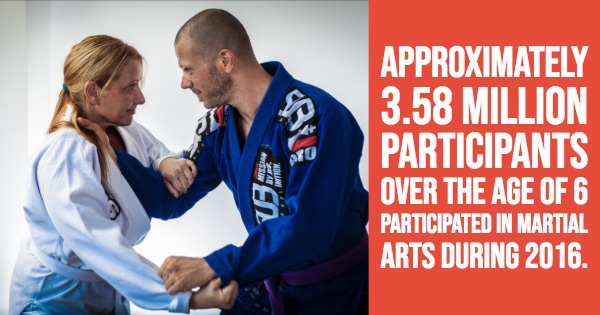 The combination of physical fitness and mental prowess makes the martial arts an enticing category for many people. In fact, approximately 3.58 million participants over the age of six participated in martial arts during 2016. Of course, there are countless martial arts disciplines to choose from. But one of the most exciting is Brazilian Jiu Jitsu, also known as BJJ. If you’ve never participated in this discipline before, you’ll want to grasp some Brazilian Jiu Jitsu basics (at least logically, if not physically) before you ever step into a martial arts studio. Here are three of the most important moves that you’ll see when participating in Jiu Jitsu for beginners or for experts.
The combination of physical fitness and mental prowess makes the martial arts an enticing category for many people. In fact, approximately 3.58 million participants over the age of six participated in martial arts during 2016. Of course, there are countless martial arts disciplines to choose from. But one of the most exciting is Brazilian Jiu Jitsu, also known as BJJ. If you’ve never participated in this discipline before, you’ll want to grasp some Brazilian Jiu Jitsu basics (at least logically, if not physically) before you ever step into a martial arts studio. Here are three of the most important moves that you’ll see when participating in Jiu Jitsu for beginners or for experts.
- Grips: When grappling on the mat, you won’t be permitted to grab onto your opponent in just any way. You’ll need to learn how to properly grip to execute some of the most important and intricate maneuvers in BJJ. You will also need to strengthen your grip over time, as those who start taking Brazilian Jiu Jitsu for beginners simply won’t have the same grip that more experienced participants will have. In addition, you’ll learn how to employ your grip at the right time and where the best locations to grip will be. Think of these grips as an essential foundation that will allow you to build your skills and eventually perform some of the more complicated techniques associated with BJJ.
- Armbars: Armbars are more complex moves that require prior knowledge (like how to properly grip). But when you start mastering some of the techniques required in Jiu Jitsu for beginners, this will likely be one of the first of the complicated moves you learn. It’s essentially a position used in a grappling context in order to force your opponent to tap out. Most often, it’s an arm lock used in submission attacks — and it’s a vital technique to know if you want to pursue BJJ.
- Guards: The guard is another common grappling position that you’ll see in Jiu Jitsu. It’s typically seen in BJJ in scenarios where one person is attempting to control another using their legs, though that person will have their back to the ground. Although it might seem counterintuitive, the person in that vulnerable looking position is actually at an advantage. If the person on top is able to transition into the more dominant position, they do what’s known as “passing the guard.” There are many other situations in which the guard may be used, including its numerous variations (full guard, open guard, half-guard, X-guard, and many more).
If you’re more familiar with the most important moves you’ll see when taking Jiu Jitsu for beginners, you’ll feel more confident and qualified to take on this challenge. Ready to get started on your BJJ journey? Contact us today to learn more.



